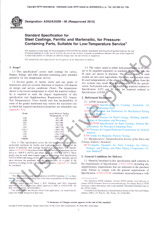We need your consent to use the individual data so that you can see information about your interests, among other things. Click "OK" to give your consent.
ASTM E1065/E1065M-20
Standard Practice for Evaluating Characteristics of Ultrasonic Search Units
Translate name
STANDARD published on 15.1.2020
The information about the standard:
Designation standards: ASTM E1065/E1065M-20
Note: WITHDRAWN
Publication date standards: 15.1.2020
SKU: NS-984111
The number of pages: 24
Approximate weight : 72 g (0.16 lbs)
Country: American technical standard
Category: Technical standards ASTM
The category - similar standards:
Annotation of standard text ASTM E1065/E1065M-20 :
Keywords:
aperture, bandwidth, characterization, contact testing, depth of field, focal point, frequency response, immersion testing, peak frequency, search unit, sound beam profile, time response, ultrasound ,, ICS Number Code 17.140.01 (Acoustic measurements and noise abatement in general)
Additional information
| Significance and Use | ||||
|
5.1 This practice is intended to provide standardized procedures for evaluating ultrasonic search units. It is not intended to define performance and acceptance criteria, but rather to provide data from which such criteria may be established. 5.2 These procedures are intended to evaluate the characteristics of single-element piezoelectric search units. 5.3 Implementation may require more detailed procedural instructions in a format of the using facility. 5.4 The measurement data obtained may be employed by users of this practice to specify, describe, or provide a performance criteria for procurement and quality assurance, or service evaluation of the operating characteristics of ultrasonic search units. All or portions of the practice may be used as determined by the user. 5.5 The measurements are made primarily under pulse-echo conditions. To determine the relative performance of a search unit as either a transmitter or a receiver may require additional tests. 5.6 While these procedures relate to many of the significant parameters, others that may be important in specific applications may not be treated. These might include power handling capability, breakdown voltage, wear properties of contact units, radio-frequency interference, and the like. 5.7 Care must be taken to ensure that comparable measurements are made and that users of the practice follow similar procedures. The conditions specified or selected (if optional) may affect the test results and lead to apparent differences. 5.8 Interpretation of some test results, such as the shape of the frequency response curve, may be subjective. Small irregularities may be significant. Interpretation of the test results is beyond the scope of this practice. 5.9 Certain results obtained using the procedures outlined may differ from measurements made with ultrasonic test instruments. These differences may be attributed to differences in the nature of the experiment or the electrical characteristics of the instrumentation. 5.10 The pulse generator used to obtain the frequency response and time response of the search unit must have a rise time, duration, and spectral content sufficient to excite the search unit over its full bandwidth, otherwise time distortion and erroneous results may result. |
||||
| 1. Scope | ||||
|
1.1 This practice covers measurement procedures for evaluating certain characteristics of ultrasonic search units (also known as “probes”) that are used with ultrasonic testing instrumentation. This practice describes means for obtaining performance data that may be used to define the acoustic and electric responses of ultrasonic search units. 1.2 The procedures are designed to measure search units as individual components (separate from the ultrasonic test instrument) using commercial search unit characterization systems or using laboratory instruments such as signal generators, pulsers, amplifiers, digitizers, oscilloscopes, and waveform analyzers. 1.3 The procedures are applicable to manufacturing acceptance and incoming inspection of new search units or to periodic performance evaluation of search units throughout their service life. 1.4 The procedures in Annex A1 – Annex A6 are generally applicable to ultrasonic search units operating within the 0.4 to 10 MHz range. Annex A7 is applicable to higher frequency immersion search unit evaluation. Annex A8 describes a practice for measuring sound beam profiles in metals from contact straight-beam search units. Additional Annexes, such as sound beam profiling for angle-beam search units in metal and alternate means for search unit characterization, will be added when developed. 1.5 Units—The values stated in either SI units or inch-pound units are to be regarded separately as standard. The values stated in each system are not necessarily exact equivalents; therefore, to ensure conformance with the standard, each system shall be used independently of the other, and values from the two systems shall not be combined. 1.6 This standard does not purport to address all of the safety concerns, if any, associated with its use. It is the responsibility of the user of this standard to establish appropriate safety, health, and environmental practices and determine the applicability of regulatory limitations prior to use. 1.7 This international standard was developed in accordance with internationally recognized principles on standardization established in the Decision on Principles for the Development of International Standards, Guides and Recommendations issued by the World Trade Organization Technical Barriers to Trade (TBT) Committee. |
||||
| 2. Referenced Documents | ||||
|
We recommend:
Updating of laws
Do you want to be sure about the validity of used regulations?
We offer you a solution so that you could use valid and updated legislative regulations.
Would you like to get more information? Look at this page.




 Cookies
Cookies
